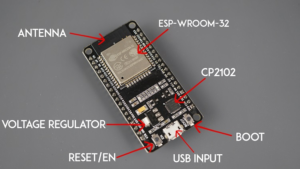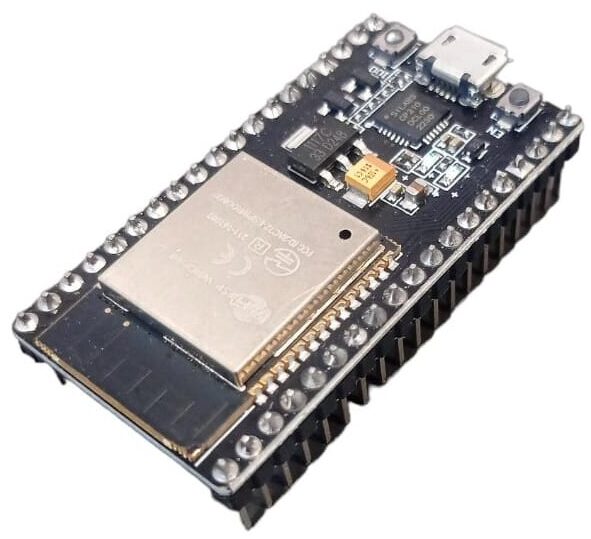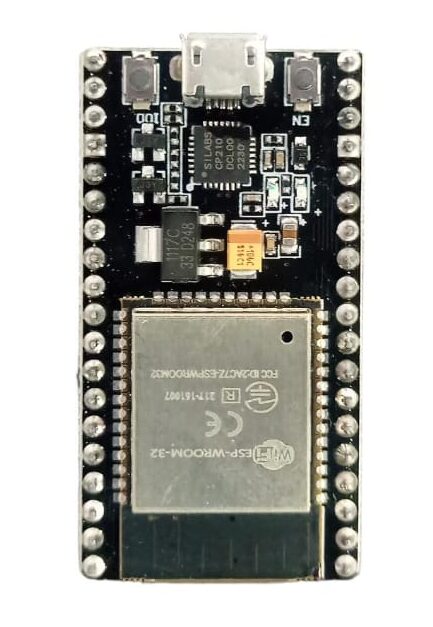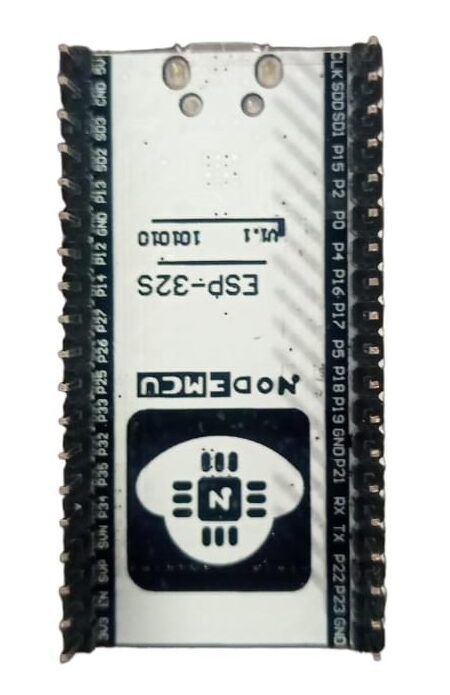ESP32 Development Board WiFi + BT + BLE : An Overview
ESP32 Development board is based on the ESP32-WROOM-32 Module, which consists of ESP32 series microcontroller from ESPRESSIF. It is a WiFi + Bluetooth + BLE development board. The module has a 32 Bit Dual Core MCU, ultra low power, based on 40 nM technology. The module supports 802.11 b/g/n along with Bluetooth v4.2 BR/EDR and BLE specification. It has integrated 4 MB Flash, and up to 512 KB RAM. It can operate at up to 240 Mhz Frequency.
Specification:
| Specification | Details |
|---|---|
| Microcontroller | Espressif ESP32 dual-core Tensilica LX6 processor |
| CPU Frequency | Adjustable up to 240 MHz |
| WiFi | 802.11 b/g/n 2.4 GHz (WEP, WPA/WPA2 PSK/Enterprise) |
| Bluetooth | Bluetooth v4.2 and Bluetooth Low Energy (BLE) |
| Flash Memory | 4 MB (32 Mbit) |
| SRAM | 520 KB |
| GPIOs | Up to 36 GPIO pins, including PWM, I2C, SPI, UART, and ADC |
| Analog Inputs | 18 (12-bit SAR ADC) |
| Digital Interfaces | I2C, SPI, UART, I2S, RMII, PWM |
| Operating Voltage | 2.2V to 3.6V |
| Operating Temperature | -40°C to 85°C |
| USB | USB to UART bridge for programming and debugging |
| Power Consumption | Varies depending on usage, optimized for low power applications |
| Dimensions | Varies depending on specific development board design |
| Development Environment Support | Arduino IDE, ESP-IDF, PlatformIO |
| Security Features | Secure Boot, Flash Encryption, WPA2-Enterprise, TLS encryption support |
| Additional Features | Sleep modes for low power operation, hardware-accelerated encryption |
Features:
- Ease of Use: Allows for quick and easy insertion and removal of ICs without soldering.
- Versatility: Compatible with a wide range of 40-pin ICs, including microcontrollers, FPGA (Field-Programmable Gate Array), memory chips, and more.
- Interchangeability: Enables ICs to be swapped out and replaced easily, facilitating testing, troubleshooting, and upgrades.
- Reliability: Provides secure electrical connections between the IC and the PCB, reducing the risk of poor connections or damage to the IC or PCB.
- Cost-Effective: Offers a cost-effective solution for mounting and connecting ICs compared to soldering directly onto the PCB.
- Standardization: Conforms to industry-standard pin layouts and pitches, ensuring compatibility with a wide range of ICs and PCB designs.

Applications:
- IoT Devices: The ESP32 Development Board is widely used in Internet of Things (IoT) projects for its ability to connect to WiFi networks and Bluetooth devices. It enables the development of smart home devices, environmental monitoring systems, and industrial automation solutions.
- Wireless Sensor Networks: With its low power consumption and support for BLE, the ESP32 Development Board is suitable for building wireless sensor networks. These networks can be deployed for environmental monitoring, asset tracking, and healthcare applications.
- Smart Agriculture: ESP32-based devices can be deployed in agricultural settings for monitoring soil moisture, temperature, humidity, and other environmental parameters. These devices can help optimize irrigation, enhance crop yields, and reduce water usage.
- Wearable Devices: The ESP32’s BLE capabilities make it suitable for developing wearable devices such as fitness trackers, smartwatches, and health monitors. These devices can communicate with smartphones and other BLE-enabled devices to provide real-time data and notifications.
- Home Automation: ESP32-based devices can be used to create smart home automation systems for controlling lights, appliances, and security cameras. These systems can be controlled remotely via WiFi or Bluetooth connectivity.
- Industrial Automation: In industrial settings, the ESP32 Development Board can be used for monitoring and controlling machinery, tracking inventory, and collecting data for predictive maintenance.
Development:
- Arduino IDE: The ESP32 Development Board can be programmed using the Arduino IDE, which provides an easy-to-use platform for developing IoT applications. Arduino libraries are available to simplify tasks such as WiFi and Bluetooth communication.
- ESP-IDF: For more advanced development, the ESP32 Development Board can be programmed using the Espressif IoT Development Framework (ESP-IDF). ESP-IDF offers greater control over the ESP32’s hardware features and provides access to low-level APIs for tasks such as WiFi and BLE communication.
- PlatformIO: PlatformIO is an alternative development platform that supports the ESP32 Development Board and provides a unified environment for programming and managing libraries. It offers features such as code debugging and project management.
- Peripheral Integration: The ESP32 Development Board features a wide range of peripherals, including GPIO pins, analog-to-digital converters (ADCs), pulse-width modulation (PWM) controllers, and I2C, SPI, and UART interfaces. Developers can leverage these peripherals to interface with sensors, actuators, displays, and other external devices.
- Power Management: The ESP32 Development Board features advanced power management capabilities, including sleep modes and power-saving features. Developers can optimize power consumption to prolong battery life in battery-powered applications.
- Security: The ESP32 Development Board includes hardware-based security features such as Secure Boot and Flash Encryption to protect against unauthorized access and code manipulation. Developers can implement additional security measures, such as TLS encryption, to secure communication over WiFi and Bluetooth connections.




Reviews
There are no reviews yet.